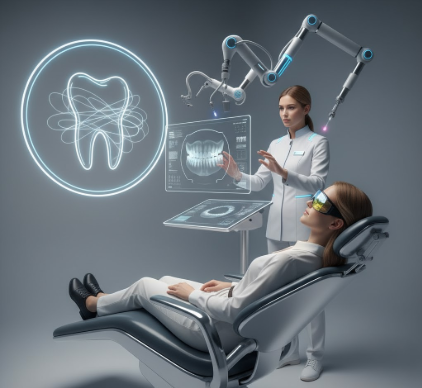Visiting the dentist has certainly changed over the decades. From rudimentary tools and guesswork to today’s relatively comfortable procedures, the evolution is undeniable. But the pace of change is accelerating rapidly. We stand on the cusp of a new era in oral healthcare, driven by technological breakthroughs and a deeper understanding of biology. The future promises dental care that is more precise, less invasive, personalized, and increasingly focused on preventing problems before they even start. Forget the often-dreaded visits of the past; tomorrow’s dental experience could look radically different.
Technological Advancements Reshaping Dentistry
Technology is the engine driving much of the transformation in dental care. Digital workflows are becoming standard, streamlining processes from diagnosis to treatment delivery. What once required multiple visits and manual labor can now often be accomplished with greater accuracy and speed thanks to digital tools.
Artificial Intelligence (AI) in Diagnostics and Treatment Planning
Artificial intelligence is quietly becoming an indispensable partner for dental professionals. AI algorithms can analyze dental X-rays, CBCT scans, and intraoral images with remarkable speed and consistency, often spotting subtle signs of decay, bone loss, or lesions that might be missed by the human eye during a routine check. This doesn’t replace the dentist’s expertise but rather augments it, acting as a second set of highly trained eyes. Furthermore, AI can assist in treatment planning by simulating outcomes for procedures like orthodontics or implant placement, helping dentists choose the most effective approach and allowing patients to visualize the potential results before committing to treatment. Predictive analytics powered by AI might even identify patients at higher risk for certain conditions, enabling proactive interventions.
3D Printing and Customized Solutions
Additive manufacturing, or 3D printing, is revolutionizing how dental restorations and appliances are made. Instead of traditional casting or milling methods, dentists can now digitally design and print highly accurate crowns, bridges, veneers, surgical guides for implant placement, orthodontic aligners, and even full dentures, often right in their own office. This technology offers several advantages: speed (sometimes enabling same-day restorations), incredible precision matching the patient’s unique anatomy, and the ability to use a wider range of advanced materials. Customization reaches a new level, ensuring a better fit and potentially longer-lasting results. The ability to quickly print a surgical guide based on a patient’s scan, for example, allows for incredibly precise implant placement, minimizing risks and improving outcomes.
Validated Technology: Intraoral scanners combined with chairside 3D printing systems are already enabling many dental practices to offer same-day crowns and bridges. This technology significantly reduces the number of appointments required for certain restorations. The accuracy of these digitally fabricated restorations is often comparable or superior to traditional methods.
Teledentistry: Expanding Access to Care
Just as telehealth has transformed general medicine, teledentistry is breaking down geographical barriers to oral healthcare. Using video conferencing, secure messaging, and digital image sharing (like photos taken with a smartphone), dentists can conduct remote consultations, monitor patients’ progress (e.g., during orthodontic treatment), provide advice, triage emergencies, and offer preliminary assessments. This is particularly valuable for individuals in rural or underserved areas, those with mobility issues, or simply for convenient follow-ups. While teledentistry cannot replace in-person examinations and procedures requiring hands-on treatment, it significantly improves access, facilitates earlier intervention, and enhances patient convenience for specific aspects of dental care.
Laser Dentistry: Minimally Invasive Procedures
Lasers have become versatile tools in the modern dental office. Different types of lasers can be used for a variety of procedures, often with less pain, bleeding, and faster healing times compared to traditional methods. Hard-tissue lasers can precisely remove decay, sometimes without the need for anesthesia, while soft-tissue lasers are effective for gum contouring, treating gum disease (periodontal therapy), performing biopsies, and treating oral ulcers. Lasers are also used in teeth whitening procedures and for detecting cavities in their earliest stages (laser fluorescence). The precision of lasers often means less removal of healthy tooth structure or gum tissue, aligning with the trend towards minimally invasive dentistry.
Focus on Prevention and Early Detection
The ultimate goal is shifting from primarily treating existing problems to actively preventing them or catching them at their most nascent stages. Future dental care will lean heavily on technologies and approaches that empower both patients and professionals in this preventative quest.
Smart Toothbrushes and Oral Health Monitoring
The humble toothbrush is getting an intelligence upgrade. Smart toothbrushes equipped with sensors can track brushing coverage, pressure applied, and duration, providing real-time feedback via connected apps. They can highlight areas the user consistently misses, coach better technique, and generate reports that can be shared with the dental team. This gamification and data-driven approach encourages better home care habits, which are fundamental to preventing cavities and gum disease. Some concepts even explore integrating sensors to detect early chemical signs of decay or inflammation directly in the mouth.
Saliva Diagnostics: The Mouth as a Window to Health
Saliva is a rich source of biological information. Emerging diagnostic technologies aim to analyze saliva for biomarkers indicating oral health conditions like gum disease, cavities (bacterial counts), and even early signs of oral cancer. Beyond the mouth, research is exploring how salivary biomarkers might correlate with systemic diseases such as diabetes, autoimmune disorders, and certain cardiovascular conditions. The potential for non-invasive, chairside saliva testing could revolutionize early detection, making screening simpler, faster, and more accessible.
Advanced Imaging Techniques
While digital X-rays are standard, Cone Beam Computed Tomography (CBCT) provides invaluable three-dimensional views of teeth, bone, nerves, and soft tissues with much lower radiation doses than traditional medical CT scans. CBCT is crucial for complex treatment planning, especially for dental implants, orthodontics, and root canal therapy. Future developments likely involve further reducing radiation exposure while enhancing image clarity and potentially incorporating AI for automated analysis of these complex 3D datasets. Near-infrared imaging (NIRI) is also gaining traction as a non-radiation method to help detect cavities between teeth.
Materials Science and Regenerative Dentistry
What goes into our mouths matters. Advancements in materials science are yielding stronger, more aesthetic, and biologically compatible options for restorations. Looking further ahead, the field of regenerative dentistry holds the tantalizing promise of rebuilding rather than simply replacing damaged oral tissues.
Biocompatible and Smarter Materials
The quest continues for dental materials that perfectly mimic natural tooth structure in both appearance and function. Zirconia, advanced ceramics, and reinforced composite resins offer excellent aesthetics and durability. Research is focused on developing “bioactive” materials that not only fill a space but can actively interact with the oral environment – for instance, materials that release fluoride to prevent secondary decay around a filling, possess antibacterial properties to inhibit plaque formation, or even encourage remineralization of adjacent tooth structure. Nanotechnology is playing a role in enhancing the properties of these materials at a microscopic level.
The Promise of Regeneration
Perhaps the most exciting frontier is regenerative dentistry. While still largely in the research phase, scientists are exploring ways to stimulate the body’s natural healing processes to repair or regenerate damaged oral tissues. This includes research into:
- Enamel and Dentin Regeneration: Using peptides, growth factors, or biomaterials to encourage the regrowth of mineralized tooth structures lost to decay.
- Pulp Regeneration: Efforts to regenerate the living tissue inside a tooth, potentially avoiding root canal therapy in some cases.
- Periodontal Regeneration: Using stem cells, scaffolds, and growth factors to rebuild bone and ligaments lost due to severe gum disease.
- Whole Tooth Regeneration: The long-term, ambitious goal of growing entirely new, functional teeth using tissue engineering and stem cell technology.
While clinical applications for most regenerative therapies are still some way off, the progress is steady and holds profound implications for the future of treating tooth loss and damage.
Important Note: While research into regenerative dentistry, particularly using stem cells, is advancing, widespread clinical treatments for regenerating entire teeth or significant portions of tooth structure are not yet available. Patients should be cautious about clinics offering unproven regenerative therapies. Current research is promising but requires further validation and regulatory approval.
The Patient Experience Reimagined
Beyond the technical procedures, the future of dentistry also involves enhancing the overall patient experience, making visits more comfortable, convenient, and less anxiety-provoking.
Virtual Reality (VR) for Anxiety Reduction
Dental anxiety is a significant barrier to care for many people. Virtual reality headsets offer a powerful distraction tool. By immersing patients in calming virtual environments – like a beach, a forest, or even interactive games – VR can significantly reduce anxiety and perceived pain during dental procedures. It shifts the patient’s focus away from the clinical setting, making treatments more tolerable, particularly for longer appointments or for those with dental phobias.
Enhanced Comfort and Personalized Care
The trend towards minimally invasive techniques, facilitated by tools like lasers and advanced imaging, naturally leads to more comfortable procedures with faster recovery times. Improved local anesthetics and sedation techniques also play a role. Furthermore, the wealth of data gathered through digital scanning, AI analysis, and potentially even genetic information will allow for truly personalized treatment plans. Care will be tailored not just to the patient’s clinical needs but also to their individual risk factors, lifestyle, preferences, and even their genetic predisposition to certain oral conditions.
The journey into the future of dental care is well underway. Driven by innovation across multiple fields – from artificial intelligence and materials science to biotechnology and digital communications – we are moving towards an era of proactive, predictive, and personalized oral health. While challenges remain in terms of cost, accessibility, and regulatory approval for some cutting-edge technologies, the trajectory is clear. Dentistry is becoming less about reactive repairs and more about maintaining lifelong health through precision, prevention, and a vastly improved patient experience. The smile of the future will be built on a foundation of science and technology, making oral healthcare more effective and accessible than ever before.









